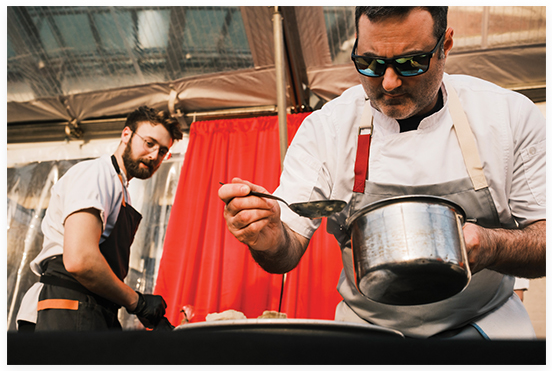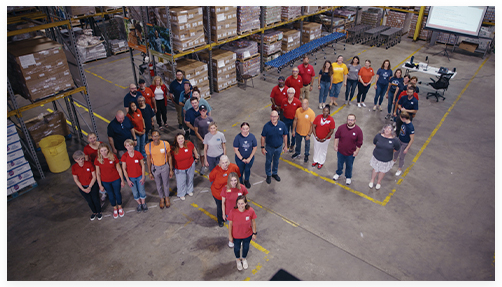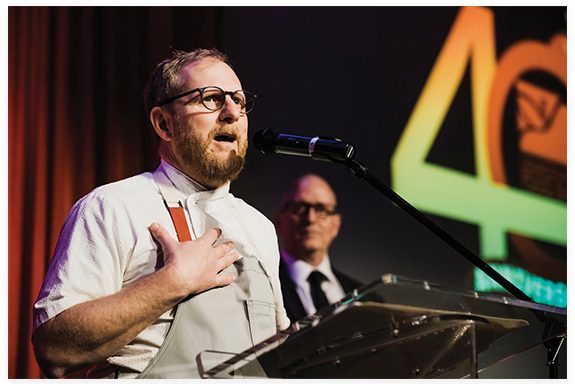The nonprofit’s 25th annual Chefs’ Feast is February 25

Staff members at last year’s Chefs’ Feast, celebrating the nonprofit’s 40th year of service.
One in seven American households experiences food insecurity. In South Carolina, the Lowcountry Food Bank (LCFB) annually serves more than 200,000 residents across the state’s 10 coastal counties. And while the food bank has fed those in need since 1983, the relief organization has recently begun responding to this timeworn problem with a modern approach.
Using geographic information system (GIS) mapping, the nonprofit merges census data and the locations of grocery stores and partner agencies to identify food deserts within its service area, which covers about 9,000 square miles. The group first teamed up with the Riley Center for Livable Communities at the College of Charleston in 2019 to introduce the idea, moving the technology in-house the following year. Now, LCFB is helping to bring other members of Feeding the Carolinas, a consortium of Feeding America food banks in North and South Carolina, into the GIS mapping future. “We’re at the forefront of using data to drive our food distribution model,” says chief development officer Brenda Shaw, pointing out that LCFB is one of a few food banks using this technology to help propel the equitable distribution of food.

2023’s Chefs’ Feast.
“Transportation plays a huge role when it comes to food deserts, so we’re looking at who in our community has to travel more than 15 minutes for groceries and help break down that barrier to food access,” says Shaw. The nonprofit then focuses efforts on arranging direct distributions or recruiting new partners to fill those gaps. LCFB collaborates with a network of more than 230 agencies, from food pantries, shelters, and soup kitchens to programs for students, seniors, and veterans. With regional distribution centers in Charleston, Myrtle Beach, and Yemassee, as well as a planned center in Hampton County, the food bank provides its partners with fresh produce and shelf-stable goods, as well as equipment (such as refrigerators and coolers), nutrition materials, and food-safety training. “It’s a sophisticated, logistical operation,” Shaw adds, noting the nonprofit easily reaches its annual goal of providing 190 meals to every person in need along the South Carolina coast. “Food security means consistent access to nutritious food in order to lead a healthy and active life,” she says.

More than 30 chefs prepared small bites for about 400 guests at 2023’s Chefs’ Feast, which raised more than $500,000 for the Lowcounty Food Bank.
Included in that mission are childhood hunger programs such as Backpack Buddies, which discreetly gives students easy-to-prepare food for weekends and school holidays; Kids Café, an after-school meal program; and the Summer Food Services Program, which delivers prepared meals to libraries and camps. In addition, LCFB has created 23 school pantries to provide boxes of shelf-stable items to help families stretch their monthly budget and is adding more school markets where caregivers can select foods of their choice to take home.

Lowcountry Food Bank staff formed a 40 in their warehouse to mark the nonprofit’s anniversary.
A significant portion of the money for these programs comes from LCFB’s longest-running fundraiser, the Chefs’ Feast, which raised more than $500,000 in 2023. Now in its 25th year, the black-tie ticket brings together some of the region’s most celebrated chefs for an evening of small bites and big bidding.

Jacques Larson has served as lead chef for the annual fundraising feast for seven years.
Shaw attributes the event’s success to the unwavering commitment of the chefs, donors, staff, and volunteers involved. “Jacques Larson [Wild Olive and Obstinate Daughter] has been the lead chef for seven years and attended the event for 24 of our 25 years,” she says, “and Marc Collins [Circa 1886] and John Zucker [Cru Café] have been volunteering for just as long.” This year also brings a return appearance by former Peninsula Grill chef Bob Carter, who served as the gala’s first lead chef, before he retired to Florida. “Guests love getting to meet and interact with these top chefs,” says Shaw. Perhaps it’s because, just as healthy meals nourish the body, nothing fills up a person’s spirit quite like community.
25th Annual Chefs’ Feast: Sunday, February 25, VIP reception 5 p.m., dining & live auction 6 p.m. Trident Technical College, 7000 Rivers Ave., North Charleston. $350 individual, $5,500-$15,000 VIP sponsor. lowcountryfoodbank.org
WATCH Lowcountry Food Bank’s 2023 video celebrating their 40th anniversary: